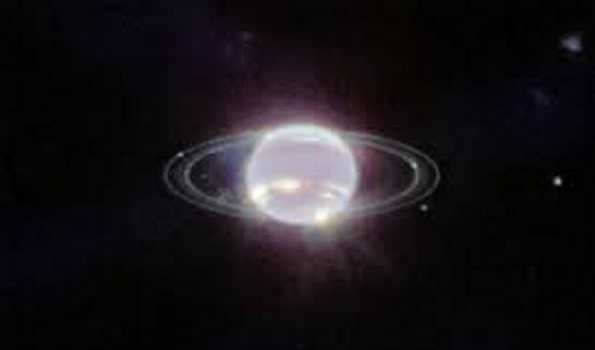NASA Webb Captures Photos Of Neptune’s Rings In Decades

Los Angeles, Sep 22: NASA’s James Webb Space Telescope has captured the clearest pictures of Neptune and its rings, according to NASA.
Webb has not only captured the clearest view of this distant plant’s rings in more than 30 years, but its cameras reveal the ice giant in a whole new light, NASA said on Wednesday.
“Hey Neptune. Did you ring? Webb’s latest image is the clearest look at Neptune’s rings in 30+ years, and our first time seeing them in infrared light. Take in Webb’s ghostly, ethereal views of the planet and its dust bands, rings and moons,” NASA Webb Telescope wrote in Twitter.
Hey Neptune. Did you ring? ?
Webb’s latest image is the clearest look at Neptune’s rings in 30+ years, and our first time seeing them in infrared light. Take in Webb’s ghostly, ethereal views of the planet and its dust bands, rings and moons: https://t.co/Jd09henF1F #IAC2022 pic.twitter.com/17QNXj23ow
— NASA Webb Telescope (@NASAWebb) September 21, 2022
In a NASA release, Heidi Hammel, a Neptune system expert and interdisciplinary scientist for Webb said, “It has been three decades since we last saw these faint, dusty rings, and this is the first time we’ve seen them in the infrared.”
Neptune was discovered by researchers in 1846 and since then, it is fascinating them. The planet is located 30 times farther from the Sun than Earth and orbits in the remote, dark region of the outer solar system. The sun is so distant for Neptune that it is similar to a din twilight on Earth.
The planet is characterized as an ice giant due to the chemical make-up of its interior. Neptune is much richer in elements heavier than hydrogen and helium as compared to the gas giants–Jupiter and Saturn.
According to the NASA release, Neptune does not appear blue to Webb in the near-infrared range from 0.6 to 5 microns. In fact, the methane gas so strongly absorbs red and infrared light that the planet is quite dark at these near-infrared wavelengths, except where high-altitude clouds are present. Such methane-ice clouds are prominent as bright streaks and spots, which reflect sunlight before it is absorbed by methane gas. Images from other observatories, including the Hubble Space Telescope and the W.M. Keck Observatory, have recorded these rapidly evolving cloud features over the years.






